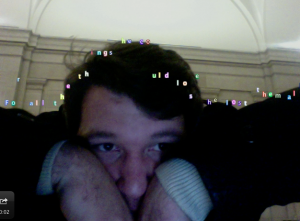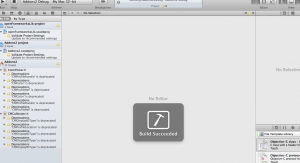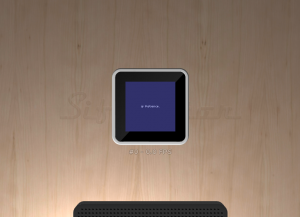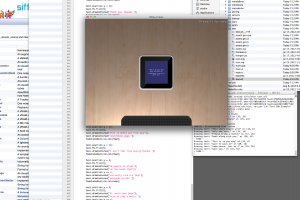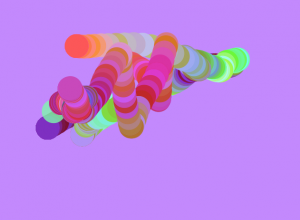Originally by Camille Utterback and Romy Achituv, I was able to run “Text Rain” in Processing. It was my first time back to Processing in a while, but I was able to figure it out after some help and practice. I simple indexed the camera’s pixels and went about it the brightness() way. Fairly reliable and quite a lot of fun getting it going. I think a performance of my lip-singing my favorite song is in order for a finished piece.
Text Rain – Re Do from Nathan Trevino on Vimeo.
My code is here.
//Nathan Trevino 2013
//Text Rain re-do. Original by Camille Utterback and Romy Achituv 1999
//Processing 2.0b7 by Nathan Trevino
//Special thanks to the processing example codes (website) as well as Golan Levin
//=============================================
import processing.video.*;
Capture camera;
float fallGravity = 1;
float fallStart = 0;
int threshold = 100;
Rain WordLetters[];
int myLetters;
//==============================================
void setup() {
//going with a larger size but am giving up speed.
size(640, 480);
camera = new Capture(this, width, height);
camera.start();
String wordString = "For all the things he could lose he lost them all";
myLetters = wordString.length();
WordLetters = new Rain[myLetters];
for (int i = 0; i < myLetters; i++) {
char a = wordString.charAt(i);
float x = width * ((float)(i+1)/(myLetters+1));
float y = fallStart;
WordLetters[i] = new Rain(a, x, y);
}
}
//==============================================
void draw() {
if (camera.available() == true) {
camera.read();
camera.loadPixels();
//Puts the video where it should be... top left corner beginning.
image(camera, 0, 0);
for (int i = 0; i < myLetters; i++) {
WordLetters[i].update();
WordLetters[i].draw();
}
}
}
//===================================
//simple key pressed fuction to start over the Rain
void keyPressed()
{
if (key == CODED) {
if (keyCode == ' ') {
for (int i=0; i < myLetters; i++) {
WordLetters[i].reset();
}
}
}
}
//=============================================
class Rain {
// This conains a single letter of the words of the entire string poem
// They fall as "individuals" and have their own position (x,y) and character (char)
char a;
float x;
float y;
Rain (char aa, float xx, float yy)
{
a = aa;
x = xx;
y = yy;
}
//=============================================
void update() {
//IMPORTANT NOTE!
// THE TEXT RAIN WORKS WITH A WHITE BACKGROUND AND THE DARK AREAS
// MOVE THE TEXT
// Updates the paramaters of Rain
// had some problems here for the pixel index, but a peek at Golan's code helped
int index = width*(int)y;
index = constrain (index, 0, width*height-1);
// Grayscale starts here. Range is defined here.
int thresholdGive = 4;
int thresholdUpper = threshold + thresholdGive;
int thresholdBottom = threshold - thresholdGive;
//find pixel colors and make it into brighness (much like alpha channeling video
// or images in Adobe photoshop or AE)
float pBright = brightness(camera.pixels[index]);
if (pBright > thresholdUpper) {
y += fallGravity;
}
else {
while ( (y > fallStart) && (pBright < thresholdBottom)) {
y -= fallGravity;
index = width*(int)y + (int)x;
index = constrain (index, 0, width*height-1);
pBright = brightness(camera.pixels[index]);
}
}
if ((y >= height) || (y < fallStart)) {
y = fallStart;
}
}
//============================
void reset() {
y = fallStart;
}
//=======================================
void draw() {
// Here I also couldn't really see my letters that well so I
// used Golan's "drop shadow" idea and some crazy random colors for funzies
fill (random(255), random(255), random(255));
text (""+a, x+1, y+1);
text (""+a, x-1, y+1);
text (""+a, x+1, y-1);
text (""+a, x-1, y-1);
fill(255, 255, 255);
text (""+a, x, y);
}
}
